by Heather Kent | Jul 28, 2022
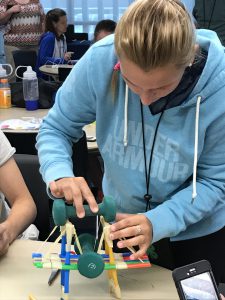 Whether you are a teen helping with a day camp, or an adult leading a club- it helps to have some tips and tricks in your back pocket to teach the content you want 4-H members to learn. 4-H volunteers and professionals often find themselves teaching a wide variety of audiences with different needs for learning. Trying to meet all those needs can sometimes seem overwhelming, but this week and next, our blog will focus on six specific strategies that will make this much easier- especially with practice! This blog post will discuss and give examples of three teaching strategies that can up your teaching and facilitation game- spacing, interleaving, and retrieval practice.
Whether you are a teen helping with a day camp, or an adult leading a club- it helps to have some tips and tricks in your back pocket to teach the content you want 4-H members to learn. 4-H volunteers and professionals often find themselves teaching a wide variety of audiences with different needs for learning. Trying to meet all those needs can sometimes seem overwhelming, but this week and next, our blog will focus on six specific strategies that will make this much easier- especially with practice! This blog post will discuss and give examples of three teaching strategies that can up your teaching and facilitation game- spacing, interleaving, and retrieval practice.
Why Bother? Isn’t the 4-H Curriculum “Good Enough?”
Some 4-H curricula have teaching strategies embedded within them. Some just have activities structured to help youth learn content. Learning and applying a few of these teaching strategies will make your teaching more interesting and engaging to a wider range of 4-H members. Engagement + interest = more fun for everyone!
Spacing
The term “spacing” simply means to spread learning out over time. When information is learned over the course of several weeks, months, or even years, youth (and adults) are more likely to retain that information than if it were dumped on them over several hours or days. This is why 4-H projects are so effective- youth often stay with the same project for one or more years, learning more complex information each year until they have mastered the content. Some project work even leads to future careers.
Here is an example of how you might apply spacing to the youth you work with in 4-H: One of the things youth want to do this year is participate in the Consumer Choices contest. Rather than teaching a marathon Saturday workshop the week before the contest, start early and introduce the concepts slowly either as part of a club meeting or an extra session before or after the regular club meeting time.
- Meeting #1- Explain why consumer skills are essential, what the topics for this year’s contest are, and the contest rules
- Meeting #2- Review cell phone plans and portable speakers (two of the topics). Demonstrate how to fill out a judging card and practice judging situations for cell phone plans and speakers.
- Meeting #3- Review ground transportation and smoothies (two more topics). Review how to fill out a judging card and practice judging situations.
- Meeting #4- Explain what oral reasons are- have an older youth demonstrate or what videos of youth giving oral reasons. Next, hold a mock contest and let youth practice giving oral reasons.
Interleaving (not to be confused with interweaving)
Interleaving means switching between topics. This allows youth opportunities to practice life skills in different situations. This helps reinforce the life skills that we teach in 4-H. For example, judging contest strategies are the same- it’s just the content that changes from contest to contest. Judging contests help youth learn about different topics, but the real value is they are learning how to think critically, communicate clearly, and work as a team. Applying those same skills to different subject matter helps youth learn lifelong skills (not just how to regurgitate facts). Here’s an example of interleaving that builds on the consumer choices example above:
The youth you work with will also want to learn about robotics, so you introduce an activity from the 4-H Junk Drawer Robotics curriculum. You divide the youth up into groups of three to complete a challenge to build a robot that draws. While teaching, refer back to what youth learned about critical thinking when they competed as a team in consumer choices. What did they learn about communication and teamwork? Ask them to apply those lessons to this situation when building a robot.
Retrieval Practice

4H youth work together in a drone course. Photo taken 10-15-18.
One of the best ways to strengthen your memory is to practice retrieving that information from your brain! Many of our 4-H curricula include games that allow youth to practice information retrieval. Quiz bowls and skill-a-thon stations are two great ways to incorporate retrieval practice. Here is an example of retrieval practice that builds upon the consumer choices example:
Youth enjoyed participating in the consumer choices contest and asked if they could do more activities like that. Your local 4-H agent suggested a program called “Living on My Own” which is a financial simulation that helps teach financial literacy skills. As the youth rotate through the stations, they retrieved and practiced some of the consumer skills they learned earlier as they decided on housing, transportation, food, and other items based on their simulated salary and living situation. Being about to recall and practice these skills helps reinforce financial literacy.
One of the best things about 4-H is it is learner-centered. That means that youth can choose what they want to do and learn in 4-H. Your local 4-H Extension Office can help you find the best curriculum to support your youths’ learning needs, but the curriculum is only part of learning. 4-H supports learning (usually referred to as a project) through a variety of competitive and non-competitive events. The three strategies described in this post can help volunteers and 4-H professionals link learning between projects and activities. Next week’s post will explore three more strategies for teaching youth- elaboration, concrete examples, and duel coding.
References:
- Potter, S. (2021). Educational Design and Delivery – Utilization of Multiple Teaching Strategies. 4-H VKRC Fact Sheets.
- Weinstein, Y., Madan, C. R., & Sumeracki, M. A. (2018). Teaching the science of learning. Cognitive Research: Principles and Implications, 3, 2. https://cognitiveresearchjournal.springeropen.com/articles/10.1186/s41235-017-0087-y
- Weinstein, Y, Sumeracki, M & Caviglioli, O (2019) Understanding how we learn: A visual guide. Routledge, Abingdon, Oxon, UK.
by Heather Kent | Jul 5, 2022
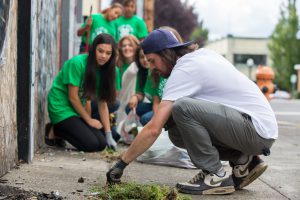 In a recent study, one of the top things 4-H volunteers are looking for are ideas for adapting activities to different age groups (Kent, 2022). Florida 4-H offers experiences for four different age groups: Cloverbuds (ages 5-7), Juniors (ages 8-10), Intermediates (ages 11-13), and Seniors (ages 14-18). One of the great things about 4-H is that the whole family can participate! This also means that 4-H volunteers often find themselves working with a variety of age groups. That might seem a little overwhelming, but this post series gives practical tips and strategies to make it less daunting. This week’s post is focused on adapting activities for intermediate-age 4-H members. In case you missed it, check out the previous couple of weeks’ posts to learn about cloverbuds, juniors, and intermediates.
In a recent study, one of the top things 4-H volunteers are looking for are ideas for adapting activities to different age groups (Kent, 2022). Florida 4-H offers experiences for four different age groups: Cloverbuds (ages 5-7), Juniors (ages 8-10), Intermediates (ages 11-13), and Seniors (ages 14-18). One of the great things about 4-H is that the whole family can participate! This also means that 4-H volunteers often find themselves working with a variety of age groups. That might seem a little overwhelming, but this post series gives practical tips and strategies to make it less daunting. This week’s post is focused on adapting activities for intermediate-age 4-H members. In case you missed it, check out the previous couple of weeks’ posts to learn about cloverbuds, juniors, and intermediates.
What are “Ages & Stages” and Why Does it Matter?
“Ages & stages” is a phrase commonly used in youth development that refers to the physical, social, emotional, and cognitive development of a young person. These categories of development are based on the work of researchers such as Piaget and Erickson. Understanding these categories help 4-H volunteers and professionals provide opportunities for youth to thrive through social and emotional learning and is a key part of the 4-H Thrive Model (Arnold & Gagnon, 2020). There are several benefits of selecting (or adapting) age-appropriate activities for youth:
- First, it makes learning fun! Fun is important; boring is bad.
- Youth are more engaged. When activities are not too challenging or too easy, they are in what’s called the “zone of proximal development,” or ZPD (Vygotsky, 1978). This is key to helping learners master new skills. ZPD refers to skills or knowledge that are too difficult for a youth to master on their own, but possible to master with guidance from a more knowledgeable person- like their 4-H volunteer!
- Youth can build on past learning experiences and create future opportunities to grow.
- When learning is fun and youth are engaged, youth stay involved in 4-H!
How to Use “Ages & Stages” to help Seniors Thrive
Social Development of 14-18 year-olds (how they act)
Youth who are 14-18 years old continue to establish a strong sense of self. They enjoy opportunities to work together as a team and develop strong friendships. They are also developing social networks and beginning to think more seriously about their future. 4-H is a great way for youth in this age group to prepare for life beyond high school by fine-tuning interview and communication skills and building a network of friends and adults that have the same interests as theirs.
| Typical social behaviors for 14-18-year olds include: |
Strategies for supporting the social development of
14-18 -year olds |
- Developing their self-identity – what makes them unique
- Continues to want more freedom from parental control and the power to make some of their own decisions
- Still likes to participate as a member of a group but is now aware of and exploring the different roles, especially that of a mentor or teacher for younger youth.
- Seeks peer group acceptance like before, plus now, status matters
- Understands the benefits of sharing and working together.
|
- Provide opportunities to share, learn and explore people’s different values, abilities, uniqueness, etc. so they can begin to identify their own
- Continue to give youth the opportunity to plan, implement and evaluate 4-H activities.
- Encourage youth to take on leadership roles and mentor younger youth
- Foster a sense of belonging in which youth are accepted, encouraged, and supported by their peers.
- Provide opportunities for youth to create groups and decide which groups they want to be in
- Build-in or plan for opportunities where youth can recognize each other’s accomplishments
|
Cognitive Development of 14-18-year-olds (how they think)
Youth that are 14-18 -years old can think logically and apply abstract reasoning, so problem-solving and critical thinking are a way to help youth in this age group learn. One of the best ways for youth in this age group to demonstrate mastery is by teaching younger youth. Many of our project areas have opportunities for older youth to serve in a “teens as teachers” role. Another way to engage older youth is in district and state leadership positions. Florida 4-H offers several opportunities for teens to plan district and statewide events through District Council and State Executive Board. Youth in this age group will also be interested in using their problem-solving and critical thinking skills to compete at the National levels in their project area.
| Typical learning behaviors for 14-18 -year olds include: |
Strategies for Supporting Cognitive Development
of 14-18-year olds: |
- Enjoys exploring ideas and these can be abstract or virtual
- Learns best when new ideas are linked to their interests
- Able to multi-task
- Able to mentor and teach younger youth
- Able to plan a whole event- especially at the District or State level
- Can apply critical thinking and problem-solving skills to National Contest opportunities.
|
- Engage teens in District and National activities, teams, projects, etc.
- Encourage teens to demonstrate mastery in their project work by teaching or mentoring younger youth with similar interests.
- Empower teens to lead and plan a wide range of activities, encouraging them to be creative and put their own “twist”
|
Throughout this series, we have been using examples from each of the three pillar programs in 4-H: Citizenship & Leadership, Science, and Healthy Living. These examples are meant to help parents and volunteers see how an activity can be adapted for each of the different age groups. For examples for other age groups, check out our previous posts about Cloverbuds, Juniors, and Intermediates.
- Citizenship & Leadership: For citizenship & leadership, we have been using the example of a 4-H club business meeting. Fourteen to 18 year olds are going to be more interested in learning about leadership roles beyond the club and county level- encourage them to run for a district or state office, or serve on a statewide planning committee for a 4-H event. Youth in this age group might also be interested in participating in the 4-H Citizenship Washington Focus to learn more about leadership and government at the national level.
- Science: For science, we have been using the 4-H entomology project as an example. Entomology is the study of insects. Youth that are 14-18 can help lead the entomology project at the county level and compete 4-H Insectathon contest to earn a college scholarship. Encourage youth to participate in a 4-H University track to learn more about careers in Entomology. Youth may also want to participate in the National 4-H Agriscience Summit.
- Healthy Living: For Healthy Living, we have been using the 4-H personal wellness project as an example. This project area helps youth learn about nutrition, physical fitness, and mental health. For seniors, they can teach a workshop on personal wellness at 4-H Teen Retreat, or apply for Community Pride funds to address a problem related to personal wellness. 4-H seniors would also be interested in attending the National 4-H Healthy Living Summit.
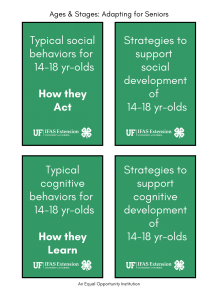 Using the “Ages & Stages” approach with youth reinforces the Essential Elements of 4-H: Belonging, Mastery, Independence, and Generosity. This is also key to helping youth thrive. However, each individual youth grows at their own pace and might not completely meet the general tendencies listed above. As volunteers and 4-H professionals, it is important to observe youth and meet them where they are physically sociality, and intellectually. Adapting activities on the fly gets easier with practice- download this set of flashcards for a quick reference guide. You can print them, cut them out, and punch them to fit on a lanyard as a handy teaching aid. Your local 4-H agent is always available to help and provide additional resources if you have questions.
Using the “Ages & Stages” approach with youth reinforces the Essential Elements of 4-H: Belonging, Mastery, Independence, and Generosity. This is also key to helping youth thrive. However, each individual youth grows at their own pace and might not completely meet the general tendencies listed above. As volunteers and 4-H professionals, it is important to observe youth and meet them where they are physically sociality, and intellectually. Adapting activities on the fly gets easier with practice- download this set of flashcards for a quick reference guide. You can print them, cut them out, and punch them to fit on a lanyard as a handy teaching aid. Your local 4-H agent is always available to help and provide additional resources if you have questions.
References:
- Arnold, M. E. & Gagnon, R. J. (2020). Positive youth development theory in practice: An update on the 4-H Thriving Model. Journal of Youth Development, 15(6), 1-23.
- Erikson, E. H. (1963). Childhood and Society (2nd Ed.). New York: Norton.
- Kent, H.C. (2022). Informal learning to support volunteer performance. [Unpublished doctoral dissertation]. Florida State University.
- Lee, F. and Go, C. (2002). Developmental stages. UC ANR 4-H Youth Development Program.
- Piaget, J. (1971). The theory of stages in cognitive development. In D. R. Green, M. P. Ford, & G. B. Flamer, Measurement and Piaget. McGraw-Hill.
- Pleskac, S. (2000). Educational design and delivery: Use of age-appropriate activities. VRKC fact sheet.
- Vygotsky, L. S. (1978). Mind in society: The development of higher psychological processes. Cambridge, MA: Harvard University Press.
by Heather Kent | Jul 3, 2022
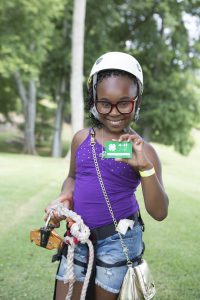 In a recent study, one of the top things 4-H volunteers are looking for are ideas for adapting activities to different age groups (Kent, 2022). Florida 4-H offers experiences for four different age groups: Cloverbuds (ages 5-7), Juniors (ages 8-10), Intermediates (ages 11-13), and Seniors (ages 14-18). 4-H encourages family involvement and engagement, and volunteers often find themselves working with a variety of age groups. That means that often, volunteers find themselves adapting activities on the fly to meet the needs of each youth. That might seem a little overwhelming, but this post series gives practical tips and strategies to make it less daunting. This week’s post is focused on adapting activities for junior age 4-H members. In case you missed it, check out last week’s post on adapting activities for Cloverbuds. This post also includes free downloadable flashcards as a handy reference tool!
In a recent study, one of the top things 4-H volunteers are looking for are ideas for adapting activities to different age groups (Kent, 2022). Florida 4-H offers experiences for four different age groups: Cloverbuds (ages 5-7), Juniors (ages 8-10), Intermediates (ages 11-13), and Seniors (ages 14-18). 4-H encourages family involvement and engagement, and volunteers often find themselves working with a variety of age groups. That means that often, volunteers find themselves adapting activities on the fly to meet the needs of each youth. That might seem a little overwhelming, but this post series gives practical tips and strategies to make it less daunting. This week’s post is focused on adapting activities for junior age 4-H members. In case you missed it, check out last week’s post on adapting activities for Cloverbuds. This post also includes free downloadable flashcards as a handy reference tool!
What are “Ages & Stages” and Why Does it Matter?
“Ages & stages” is a phrase commonly used in youth development that refers to the physical, social, emotional, and cognitive development of a young person. These categories of development are based on the work of researchers such as Piaget and Erickson. Understanding these categories help 4-H volunteers and professionals provide opportunities for youth to thrive through social and emotional learning and is a key part of the 4-H Thrive Model (Arnold & Gagnon, 2020). There are several benefits of selecting (or adapting) age-appropriate activities for youth:
- First, it makes learning fun! Fun is important; boring is bad.
- Youth are more engaged. When activities are not too challenging or too easy, they are in what’s called the “zone of proximal development,” or ZPD (Vygotsky, 1978). This is key to helping learners master new skills. ZPD refers to skills or knowledge that are too difficult for a youth to master on their own, but possible to master with guidance from a more knowledgeable person- like their 4-H volunteer!
- Youth can build on past learning experiences and create future opportunities to grow.
- When learning is fun and youth are engaged, youth stay involved in 4-H!
How to Use “Ages & Stages” to help Juniors Thrive
Social Development of 8-10 year-olds (how they act)
Youth who are 8-10 years old are learning how to be competent at activities valued by adults or their peers. When they struggle with competence, it is easy for them to feel inferior. It is best not to compare one youth to another. Instead, focus on how youth improve over time. Use the “oreo” method to compliment them on something they do well, then give them some constructive feedback, followed by another compliment.
| Typical social behaviors for 8-10-year-olds include: |
Strategies for supporting social development of 8-10-year-olds: |
- Participates as a member of a group and contributes to the group effort
- Still prefer same-gender friendships of short duration, often moving from one friend group to another
- Peer group acceptance is important
- Understands and practice sharing
|
- Help youth identify “what they are good at.” This ties in really well with sparks to create a strong environment for positive youth development
- Focus on helping youth achieve their personal best, such as comparing this month’s archery score with last month’s score. Avoid comparing youth to each other.
- When working with mixed-gender groups, provide opportunities for same-gender activities
- Encourage youth to recognize peers’ accomplishments, not just their own.
|
Cognitive Development of 8-10-year-olds (how they think)
Youth who are 8-10 years old are beginning to learn how to think more abstractly. They can now think in terms of cause and effect and understand the logic behind concrete events. They are also beginning to be able to “see” mental representations of ideas or concepts, such as the water cycle.
| Typical learning behaviors for 8-10-year-olds include: |
Strategies for Supporting Cognitive Development of 8-10-year-olds: |
- The attention span of about 40 minutes
- Likes to explore ideas especially if related to a hands-on or concrete experience
- Can do simple multi-tasking
- Learns best when new ideas are related to a piece of previous knowledge or experience
- Understands reasons behind right and wrong and can apply it
- Able to develop simple plans
- Beginning to understand give and take
- Interest expands beyond the home to extend to neighborhood and community
- Beginning to see people as individuals with unique thoughts, ideas, beliefs, and values
|
- Continue to keep youth engaged by using different teaching methods (e.g., hands-on, watch a video, pair off, etc.)
- Start your activities with the hands-on experience as much as possible, and keep instructions simple and brief
- Present a new idea or activity by referring to things that the youth already know such as “last month we learned about different types of horse feed. This month we are going to learn about the digestive system of a horse by building a model”
- Avoid telling youth about right or wrong, instead, ask them why this could be right or wrong…
- Engage youth in planning but set reasonable expectations – do not expect them to plan a whole event.
- Use community service opportunities to help youth learn about their neighborhood
- Engage youth to share their family traditions, customs, values, etc.
|
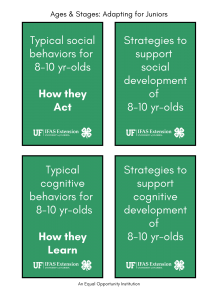
Examples of Ages & Stages Applied for Juniors
Throughout this series, we have been using examples from each of the three pillar programs in 4-H: Citizenship & Leadership, Science, and Healthy Living. These examples are meant to help parents and volunteers see how an activity can be adapted for each of the different age groups. For examples for other age groups, check out our previous post about Cloverbuds.
- Citizenship & Leadership: For citizenship & leadership, we have been using the example of a 4-H club business meeting. Eight to 10-year-olds can follow the club meeting script to begin to learn about the order of a business meeting. You can write a different role on popsicle sticks, then ask youth to draw a role at the beginning of each meeting. Y This way, they begin to learn about leadership roles and the business meeting model without the pressure of needing to know what to say. Eight to 10-year-olds will also want to be involved in committee work, led by an older, more experienced youth or with the help of a parent volunteer. During committee meetings, allow youth to plan parts of club events such as celebrations, fundraisers, or service projects.
- Science: For science, we have been using the 4-H entomology project as an example. Entomology is the study of insects. Eight to 10-year-olds can catch and begin to identify insects using a simple key. They may also want to pin and display their insects at their county or regional fair. They could also team up with a friend and give an illustrated talk or demonstration about what they have learned about insects for their club or county events.
- Healthy Living: For Healthy Living, we have been using the 4-H personal wellness project as an example. This project area helps youth learn about nutrition, physical fitness, and mental health. For juniors, this could be an opportunity for them to explore other cultures through food. Ask different youth to share what their family’s favorite meals are. This is a great way for them to cultivate learning beyond their home to include their neighborhood and community.
Using “Ages & Stages” approach with youth reinforces the Essential Elements of 4-H: Belonging, Mastery, Independence, and Generosity. This is also key to helping youth thrive. However, each individual youth grows at their own pace and might not completely meet the general tendencies listed above. As volunteers and 4-H professionals, it is important to observe youth and meet them where they are physically sociality, and intellectually. Adapting activities on the fly gets easier with practice- download this set of flashcards for a quick reference guide. You can print them, cut them out, and punch them to fit on a lanyard as a handy teaching aid. Your local 4-H agent is always available to help and provide additional resources if you have questions.
References:
Arnold, M. E. & Gagnon, R. J. (2020). Positive youth development theory in practice: An update on the 4-H Thriving Model. Journal of Youth Development, 15(6), 1-23.
Erikson, E. H. (1963). Childhood and Society (2nd Ed.). New York: Norton.
Kent, H.C. (2022). Informal learning to support volunteer performance. [Unpublished doctoral dissertation]. Florida State University.
Lee, F. and Go, C. (2002). Developmental stages. UC ANR 4-H Youth Development Program.
Piaget, J. (1971). The theory of stages in cognitive development. In D. R. Green, M. P. Ford, & G. B. Flamer, Measurement and Piaget. McGraw-Hill.
Pleskac, S. (2000). Educational design and delivery: Use of age-appropriate activities. VRKC fact sheet.
Vygotsky, L. S. (1978). Mind in society: The development of higher psychological processes. Cambridge, MA: Harvard University Press.
by pmdavis | Jul 1, 2022
It’s hard to believe the 4th of July is already upon us!
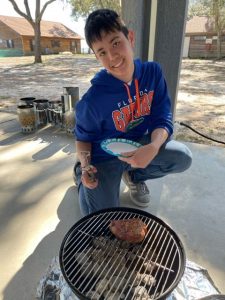
Youth learning to grill during 4-H tailgate program
Many of us will be celebrating with picnics, cookouts, and family get-togethers. One of my colleagues in Clay County, Samantha Murray, did a great article about preventing food poisoning while celebrating. Our youth have also been attending grilling summer camp programs and learning many of these tips plus lots more. The youth have learned about how to use a grill safely, how to prepare food safely and prevent cross-contamination or food-borne illness, and the nutritional benefits of animal protein in diets. Our district will have its annual competition to advance to the state-level competition on July 30 at the Washington County Extension Office, in Chipley, Florida.
I just wanted to take a moment to recap the tips Samantha gave to keep all of us safe and healthy while celebrating.
- Keep raw meats in a separate cooler than ready-to-eat items or beverages.
- Foods with mayonnaise are less acidic creating a better environment for bacterial growth
- Chicken and ground beef needs to be cooked to 165°F
- Wash hands if soap and water are not available use hand sanitizer to reduce the risk of contaminating food.
- Use different tongs or spatulas for cooked and uncooked meat or wash them after being in contact with raw meat.
- It is recommended to refrigerate leftovers within two hours unless it’s really hot, then the window shrinks to about an hour.
Other items you may want to think about.
- Keep beverages in a separate cooler from other foods, people will be going in and out of beverage coolers much more keeping the temperature higher and allowing bacterial growth.
- Cook cuts of pork, beef, or shrimp to 145°F
- Don’t sit charcoal grills on plastic tables and make sure the area is free from debris that can catch fire, including limbs or tents overhead.
- Clean up after yourself leaving only footprints in the area you were in!
- Enjoy time with friends and family safely!
For more information about educational programs, check out our webpage or contact your local UF IFAS Extension Office.
by Heather Kent | Jul 1, 2022
 In a recent study, one of the top things 4-H volunteers are looking for are ideas for adapting activities to different age groups (Kent, 2022). Florida 4-H offers experiences for four different age groups: Cloverbuds (ages 5-7), Juniors (ages 8-10), Intermediates (ages 11-13) and Seniors (ages 14-18). 4-H encourages family involvement and engagement, and volunteers often find themselves working with a variety of age groups. Each of these age groups have unique needs related to their social and cognitive development. Over the next few weeks, our blog will provide tips and ideas for adapting 4-H curriculum and activities to meet these needs.
In a recent study, one of the top things 4-H volunteers are looking for are ideas for adapting activities to different age groups (Kent, 2022). Florida 4-H offers experiences for four different age groups: Cloverbuds (ages 5-7), Juniors (ages 8-10), Intermediates (ages 11-13) and Seniors (ages 14-18). 4-H encourages family involvement and engagement, and volunteers often find themselves working with a variety of age groups. Each of these age groups have unique needs related to their social and cognitive development. Over the next few weeks, our blog will provide tips and ideas for adapting 4-H curriculum and activities to meet these needs.
What are “Ages & Stages” and Why Does it Matter?
“Ages & stages” is a phrase commonly used in youth development that refers to the physical, social, emotional, and cognitive development of a young person. These categories of development are based on the work of researchers such as Piaget and Erickson. Understanding these categories help 4-H volunteers and professionals provide opportunities for youth to thrive through social and emotional learning and is a key part of the 4-H Thrive Model (Arnold & Gagnon, 2020). There are several benefits of selecting (or adapting) age-appropriate activities for youth:
- First, it makes learning fun! Fun is important; boring is bad.
- Youth are more engaged. When activities are not too challenging or too easy, they are in what’s called the “zone of proximal development,” or ZPD (Vygotsky, 1978). This is key to helping learners master new skills. ZPD refers to skills or knowledge that are too difficult for a cloverbud to master on their own, but possible to master with guidance from a more knowledgeable person- like their 4-H volunteer!
- Youth can build on past learning experiences and create future opportunities to grow.
- When learning is fun and youth are engaged, youth stay involved in 4-H!
How to Use “Ages & Stages” to help Cloverbuds Thrive
Social Development of 5-7-year-olds (how they act)
Youth who are 5-7 years old are learning how to develop their own initiative. Giving them opportunities to initiate activities and learn from others is important. Instead of telling them what to do every time, provide them with a chance to ask questions and develop initiative- when they do, be sure to recognize their efforts and encourage them.
| Typical social behaviors for 5-7-year-olds include: |
Strategies for supporting social development of 5-7-year-olds: |
- Tendency to be self-centered, but starting to learn to share
- Learning to be a group member: to listen when others speak
- Want to be liked, especially by older youth and adults
|
- Use role-playing opportunities to act out scenarios
- Limit activities to small groups to allow peer and adult interactions; UF requires a supervision ratio of one adult for every eight cloverbud age youth.
- Be intentional about recognizing youth accomplishments (even the little things)
- Focus on activities that are cooperative rather than competitive to foster sharing and encouragement.
- Build-in unstructured time for play and creativity (follow the 4-H club model: short business meeting, educational program, and time for recreation).
|
Cognitive Development of 5-7-year-olds (how they think)
Youth who are 5-7 years old are usually still egocentric- that means they typically think about things only from their personal point of view. They like to use symbols in play, and want to define and classify things by how they are used. It is hard for them to understand cause and effect relationships, and have difficulty multi-tasking.
| Typical learning behaviors for 5-7-year olds include: |
Strategies for Supporting Cognitive Development of 5-7-year-olds: |
- Their attention span is limited to 20-30 minutes (so keep those educational programs short, with breaks for play in-between).
- They learn best when they can be active while learning (no long lectures or PowerPoints, instead, short instructions with interactive activities they can do with their hands).
- They enjoy doing simple sorting and categorizing- this can be a great way to teach new knowledge, such as the parts of a plant, or tool or animal identification)
- They are concerned with right and wrong, so explaining and enforcing basic ground rules is important.
|
- Use breaks and balance group and individual time to keep youth engaged
- As much as possible, use activities where youth can physically manipulate objects with their hands to learn
- Plan for simple activities, such as identifing types of butterflies instead of identifying types of insects which is more complex
- Help youth focus on the process, rather than the end product. For example, talk about how youth are learning how to identify different types of butterflies rather than how many they got correct.
- Model questioning and inquiry to help foster learning: “why do you think this butterfly has this type of pattern?”
|
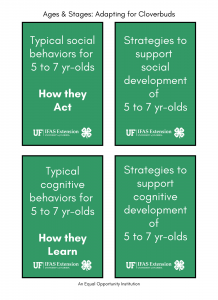
Examples of Adapting Activities for Cloverbuds. Throughout this series, we have been using examples from each of the three pillar programs in 4-H: Citizenship & Leadership, Science, and Healthy Living. These examples are meant to help parents and volunteers see how an activity can be adapted for each of the different age groups. For examples for other age groups, check out our posts about Juniors, Intermediates, and Seniors.
- Citizenship & Leadership: For citizenship & leadership, we have been using the example of a 4-H club business meeting. Five to 7 year-olds aren’t ready to serve in an executive leadership position. However, they can do things like lead the American and 4-H Pledges. They can also contribute ideas to help plan the club calendar. If you have a large number of Cloverbuds in your club, you will want to keep the business meeting short!
- Science: For science, we have been using the 4-H entomology project as an example. Entomology is the study of insects. Youth in the Cloverbud age range really enjoy categorizing and sorting things, so insect ID can be a fun way for them to engage. However, keep the categories simple; instead of handing them a dichotomous guide (that they probably can’t read). Ask them to identify insects with wings vs insects without wings. Or insects with different types of mouthparts, after explaining what the five basic mouthparts are.
- Healthy Living: For Healthy Living, we have been using the 4-H personal wellness project as an example. This project area helps youth learn about nutrition, physical fitness, and mental health. For Cloverbuds, exposing them to different types of fruits and vegetables is a fun way for them to learn about nutrition. For example, you could do a taste test of different types of apples and have them vote for their favorite. This age group would also enjoy growing some of their own food- so think about growing different types of lettuce (which grows quickly in the cooler months in Florida) or cucumbers in the hotter months.
Spending some time thinking about 4-H activities through the “Ages & Stages” lens reinforces the Essential Elements of 4-H: Belonging, Mastery, Independence, and Generosity. They are also key to helping youth thrive. However, each individual youth grows at their own pace and might not completely meet the general tendencies listed above. As volunteers and 4-H professionals, it is important to observe youth and meet them where they are physically sociality, and intellectually. Adapting activities on the fly gets easier with practice- download this set of flashcards for a quick reference guide. You can print them, cut them out, and punch them to fit on a lanyard as a handy teaching aid. Your local 4-H agent is always available to help and provide additional resources if you have questions.
References:
Arnold, M. E. & Gagnon, R. J. (2020). Positive youth development theory in practice: An update on the 4-H Thriving Model. Journal of Youth Development, 15(6), 1-23.
Erikson, E. H. (1963). Childhood and Society (2nd Ed.). New York: Norton.
Kent, H.C. (2022). Informal learning to support volunteer performance. [Unpublished doctoral dissertation]. Florida State University.
Lee, F. and Go, C. (2002). Developmental stages. UC ANR 4-H Youth Development Program.
Piaget, J. (1971). The theory of stages in cognitive development. In D. R. Green, M. P. Ford, & G. B. Flamer, Measurement and Piaget. McGraw-Hill.
Pleskac, S. (2000). Educational design and delivery: Use of age-appropriate activities. VRKC fact sheet.
Vygotsky, L. S. (1978). Mind in society: The development of higher psychological processes. Cambridge, MA: Harvard University Press.
by Claire Davis | May 6, 2022
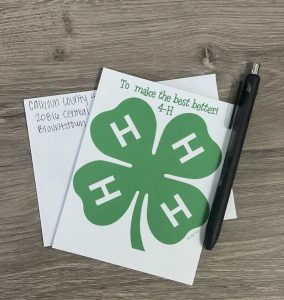 How do you know when it is appropriate to send a thank you card? Have you ever received a gift from someone? Did a volunteer donate their time for an event or for a club meeting? Are you in 4-H and someone purchased your project animal at auction? If you answered yes to any of these questions, then you should have written a thank you note to them! It does not just have to be a life changing event, such as a wedding, birthday, or baby shower, that warrants a thank you card. Whenever someone has done something nice for you, it is definitely worth sending them a thank you card.
How do you know when it is appropriate to send a thank you card? Have you ever received a gift from someone? Did a volunteer donate their time for an event or for a club meeting? Are you in 4-H and someone purchased your project animal at auction? If you answered yes to any of these questions, then you should have written a thank you note to them! It does not just have to be a life changing event, such as a wedding, birthday, or baby shower, that warrants a thank you card. Whenever someone has done something nice for you, it is definitely worth sending them a thank you card.
Writing thank you notes is a skill that many people should have, but many overlook. What exactly do you need to say in your thank you note? Here is an easy guide for a few things that you should include in your thank you note, regardless of the reason you are writing it!
Make sure that you start off by thinking of why you are writing a thank you note! Thank you notes let the individuals know that you care, that you are proud of your accomplishments, or make them feel appreciated for something that they have done for you!
-

A decorated academic cap at commencement. Photo taken 04-29-17.
Make the letter personal by starting with a salutation. Address the individual(s) by their name. If it is someone that you are well acquainted with, it is alright for you to address them by their first name. If it is someone that you are not as familiar with, stick to Mr., Mrs., Ms, and/or Miss last name. Below are a few examples of how to address someone:
Dear Aunt Renae,
Dear Lilly,
Dear Mr. and Mrs. Leonard,
- Get right to the point and express your gratitude. Some examples could be:
“Thank you so much for your generous wedding gift.”
“Thank you for the birthday present.”
“Thank you for donating your time at the Horse Club Meeting.”
“Thank you for purchasing my steer at the Calhoun County Livestock Show.”
- Maybe mention a specific detail or two. There is no need to exaggerate about their gift, but tell them what it might be used for or what you appreciate about it. Here are a few examples of things to say.
“I am so excited to get to use the birthday money on my upcoming trip to Disney World.”
“I’ve had my eye on a smoothie maker, and now I am a smoothie making machine!”
“We are saving the wedding money to help build our future home together.”
“The knowledge you shared at the meeting is incredibly valuable and the kids were soaking it up!”
“I am going to save the money from my 4-H steer project in my college fund.”
- Look ahead to the future. You may be excited about your trip to Disney World or the new smoothie machine, but make sure they know that you appreciate them or enjoyed working with them. If you are likely to spend time with them again in the future, this is a good way to move your letter towards wrapping up.***This suggestion may not apply to every letter.
“I can’t wait to have dinner with you again.”
“I’ll be up that way here in a few months and would love to see you.”
“I am interested in the position and look forward to hearing from you soon.”
“We cannot wait to have you teach us again at the club meeting next month.”
- Wrap it up with another thank you and sign off. Make sure that your letter is clear, you want to thank them for their time, donation, money, etc. You do not have to use fancy language to end your letter.
“Thank you again for thinking of us on our special day!”
“Thank you for being so generous to our organization.”
“Again, thank you for spending your time with us.”

Albert the Alligator Florida Gator mascot holding a thank you sign. Photo taken 11-16-16.
Make sure to end your letter appropriately, whether that be professionally or casually.
“Warmly,”
“With love,”
“Sincerely,”
When in doubt, write a thank you card. Your recipient will feel extra special that you want to show them your gratitude!
 Whether you are a teen helping with a day camp, or an adult leading a club- it helps to have some tips and tricks in your back pocket to teach the content you want 4-H members to learn. 4-H volunteers and professionals often find themselves teaching a wide variety of audiences with different needs for learning. Trying to meet all those needs can sometimes seem overwhelming, but this week and next, our blog will focus on six specific strategies that will make this much easier- especially with practice! This blog post will discuss and give examples of three teaching strategies that can up your teaching and facilitation game- spacing, interleaving, and retrieval practice.
Whether you are a teen helping with a day camp, or an adult leading a club- it helps to have some tips and tricks in your back pocket to teach the content you want 4-H members to learn. 4-H volunteers and professionals often find themselves teaching a wide variety of audiences with different needs for learning. Trying to meet all those needs can sometimes seem overwhelming, but this week and next, our blog will focus on six specific strategies that will make this much easier- especially with practice! This blog post will discuss and give examples of three teaching strategies that can up your teaching and facilitation game- spacing, interleaving, and retrieval practice.










